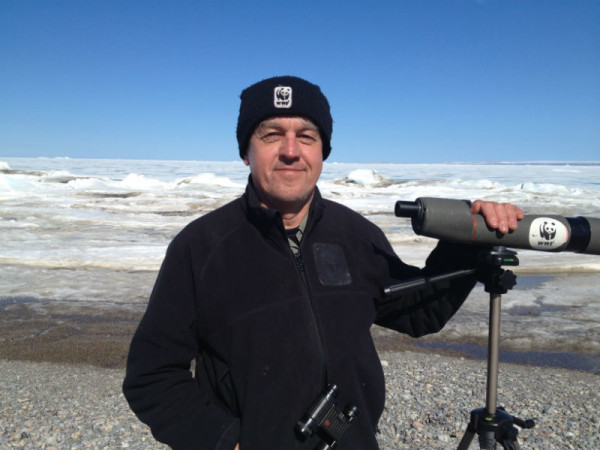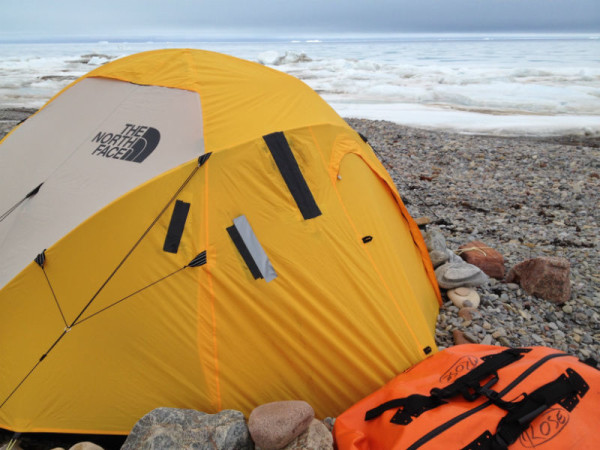On the Edge of Life: filming with National Geographic on Lancaster Sound
During the last two weeks of June, when the sun holds firm far above the horizon at the northern tip of Baffin Island, there is a lot of opportunity to think about the big picture. The beauty—and fragility—of life surrounds you, much like the unending snow and ice of the Arctic tundra.
In June, I found myself in this contemplative mood when I took part in a field camp on Lancaster Sound, at the southern edge of the Last Ice Area, (where year-round ice conditions are projected to persist the longest in the face of rapid climatic change) with WWF’s partner the National Geographic Society. As part of their Pristine Seas global conservation initiative, a team of talented photographers and knowledgeable local Inuit were there to gather images and narrative of real field experiences with the wildlife and people who live in these ice-dominated ecosystems.
As a wildlife conservation specialist, I have travelled extensively in these stunning, harsh and remote places, and was part of the team that each day decided on the best ways to help gather footage and interviews for the Pristine Seas initiative. It was a huge delight to work with top-notch equipment and people, backed by generous and ambitious funders. However, though we were there to focus on the future survival of Arctic species, the threats to our own lives were never idle—a fact the team witnessed first-hand.
The camp was over 150 kilometres from the nearest human settlement. As you might expect from this sort of expedition, we were well organized. The 22 of us were supported by a single- Otter aircraft, a Eurostar helicopter, skidoos, komatiq sleds, and quads, Honda generators and a fine kitchen tent (and even delicious pizza topped with purple saxifrage—Nunavut’s territorial flower—that we created from the bounty of the tundra). We were comfortable but worked hard, trying to capture every aspect of wildlife adapted superbly to the sea-ice dominated ecosystem.
The comfort level dropped significantly one night, when team leader Paul Rose came face-to-face with a polar bear. Paul was awoken suddenly when a full-sized polar bear pounced on his tent, possibly mistaking it for a snow cave where ringed seals often hide their pups. Paul was pinned beneath the weight of the giant bear, whose dinner plate-sized paws missed his head by only a few inches. Realizing this was something other than a tasty buffet of seal pup, the bear backed away (slashing/ripping Paul’s tent in the process), but would spend the next few minutes circling the tent, trying to figure out what to do next. Listening to his account of the near-miss, Paul told us he locked eyes with the bear for at least two minutes before it finally lost interest and plodded away. It was likely only due to the fact that food is so plentiful this time of year in Lancaster Sound that Paul was able to escape the ordeal with nothing more than a few bruises and a sore shoulder.
From that night-on, every one of the forays out to film and write about this amazingly harsh habitat seemed to be marked by the thought of how all of us—animals, humans, and plants—live so close to the edge out here. One slip and successful life turns into death. Survival depends on a full respect and understanding of the weather, the ice, and the wildlife.
The people of Mittimatalik (Pond Inlet), including our guide Jake and his dog, along with the film’s Inuk lead character, Theo Ikummaq, provided a steady reminder of how careful, patient, and long-term-thinking people must undertake in order to persist and thrive.
People who live on the land also know that survival hinges on taking proper care of it. For decades Inuit in this region have been asking for a National Marine Conservation Area (NMCA) to be designated in Lancaster Sound. This designation would protect the sensitive ecology of the area from high-risk activities such as oil and gas extraction, helping local residents to avoid lengthy court battles like the one happening in nearby Clyde River.
Just spending time on the floe edge, it becomes so obvious that the bounty of Lancaster Sound demands protection. Almost daily the team filmed bowhead whales, narwhals, belugas, walruses, thousands of seabirds, eider ducks, ringed seals and, of course, polar bears! Nowhere else in the Canadian Arctic does such high diversity and numbers of wildlife exist. As sea-ice continues to retreat northwards, driven by unprecedented rapid increase in global greenhouse gases, it is crucial that we take the steps necessary to safeguard these areas for the sake of all those who call the region home.




